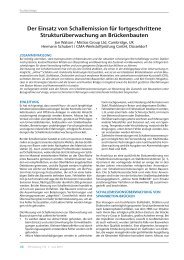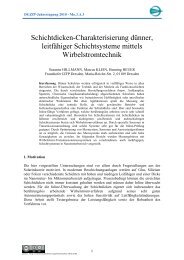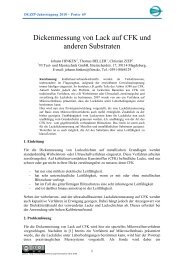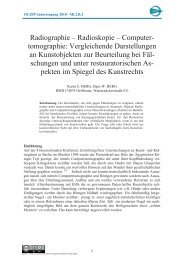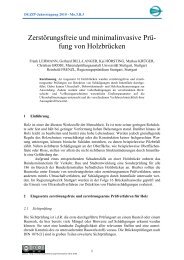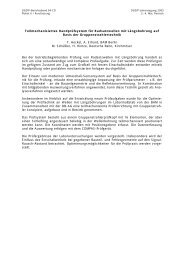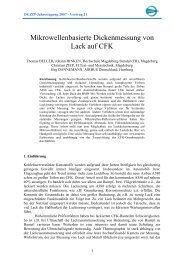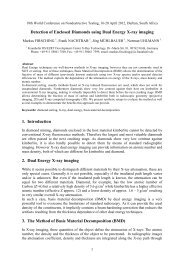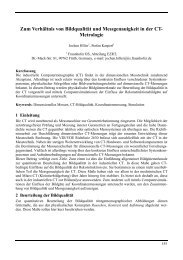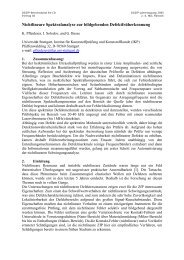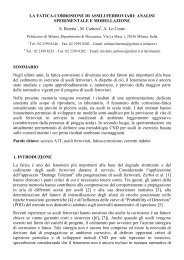The Early Use of Prussian Blue in Paintings - NDT.net
The Early Use of Prussian Blue in Paintings - NDT.net
The Early Use of Prussian Blue in Paintings - NDT.net
Create successful ePaper yourself
Turn your PDF publications into a flip-book with our unique Google optimized e-Paper software.
immediately by artists, but such was not the case." and "...it appears to have been well<br />
established by the middle <strong>of</strong> the eighteenth century..." [Harley]. Assum<strong>in</strong>g the stylistic dat<strong>in</strong>g<br />
<strong>of</strong> the pa<strong>in</strong>t<strong>in</strong>gs is correct, this means that <strong>Prussian</strong> blue must have found its way from Berl<strong>in</strong><br />
to Paris by around 1710 at the latest.<br />
Figure 1: A. Watteau, "La mariée de village" (SPSG, Sanssouci Palace, Inv. No. GK I 5603, photo: W. Pfauder)<br />
Watteau pa<strong>in</strong>ted the sky and figures with ultramar<strong>in</strong>, and an underlayer conta<strong>in</strong><strong>in</strong>g <strong>Prussian</strong> blue.<br />
<strong>The</strong> question <strong>of</strong> the early use <strong>of</strong> <strong>Prussian</strong> blue is <strong>of</strong> some importance, because the presence or<br />
absence <strong>of</strong> the pigment <strong>in</strong> art objects is frequently used for their relative dat<strong>in</strong>g, and to answer<br />
questions concern<strong>in</strong>g authenticity. This work aims to clarify some misunderstand<strong>in</strong>gs<br />
concern<strong>in</strong>g the first production and use <strong>of</strong> <strong>Prussian</strong> blue <strong>in</strong> pa<strong>in</strong>t<strong>in</strong>gs. In order to do this,<br />
historical sources were studied and a number <strong>of</strong> pa<strong>in</strong>t<strong>in</strong>gs were analysed <strong>in</strong> search <strong>of</strong> new<br />
material f<strong>in</strong>d<strong>in</strong>gs.<br />
APPROACH OF PIGMENT ANALYSIS<br />
<strong>The</strong> search for <strong>Prussian</strong> blue <strong>in</strong> pa<strong>in</strong>t<strong>in</strong>gs <strong>of</strong> the beg<strong>in</strong>n<strong>in</strong>g <strong>of</strong> the 18th Century can be rather<br />
difficult. This holds especially true for Watteau, as many <strong>of</strong> his pa<strong>in</strong>t<strong>in</strong>gs have undergone<br />
several conservation and restoration campaigns, <strong>of</strong>ten dat<strong>in</strong>g back to as early as the 18th<br />
Century. This makes not only the analysis <strong>of</strong> pigments difficult; there is also the risk <strong>of</strong><br />
confus<strong>in</strong>g orig<strong>in</strong>al with later <strong>in</strong>gredients. <strong>The</strong> <strong>Prussian</strong> blue applied by the artists reacts<br />
sensitively to light. In some pa<strong>in</strong>t<strong>in</strong>gs it has strongly faded, or has changed <strong>in</strong>to a grey colour.<br />
A basic pr<strong>in</strong>ciple <strong>of</strong> this <strong>in</strong>vestigation was to take no samples from the visible areas <strong>of</strong> the<br />
pa<strong>in</strong>t<strong>in</strong>gs. <strong>The</strong> pigments were studied with non-destructive methods, us<strong>in</strong>g a complementary<br />
comb<strong>in</strong>ation <strong>of</strong> optical microscopy, micro X-ray fluorescence analysis and optical<br />
spectroscopy <strong>in</strong> reflection mode [Bartoll et al.]. In a few cases, samples were taken from pa<strong>in</strong>t<br />
layers from the outer edges or tack<strong>in</strong>g marg<strong>in</strong>s <strong>of</strong> the pa<strong>in</strong>t<strong>in</strong>g, <strong>in</strong> order to produce cross<br />
sections, and to carry out <strong>in</strong>frared spectroscopy.<br />
<strong>The</strong> X-ray fluorescence (XRF) measurements were performed us<strong>in</strong>g the mobile energydispersive<br />
X-ray fluorescence spectrometer "ARTAX" (Bruker AXS Microanalysis GmbH,<br />
Berl<strong>in</strong>, Germany) [Bronk et al.]. <strong>The</strong> use <strong>of</strong> open helium purg<strong>in</strong>g equipment for the excitation<br />
and detection paths enabled the detection <strong>of</strong> all elements down to sodium. All spectra were<br />
measured us<strong>in</strong>g a voltage <strong>of</strong> 45 kV, and a current <strong>of</strong> 600 µA for the excitation.<br />
2



